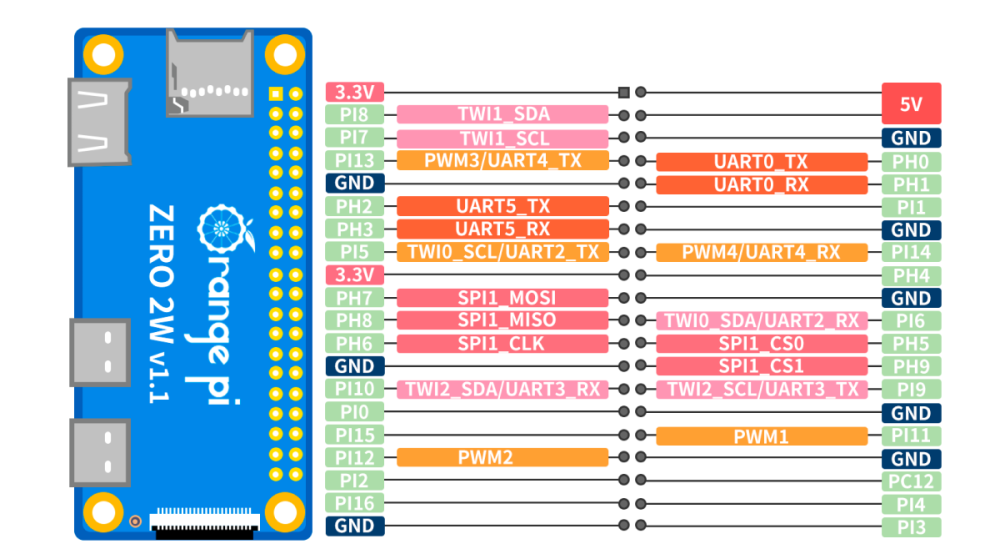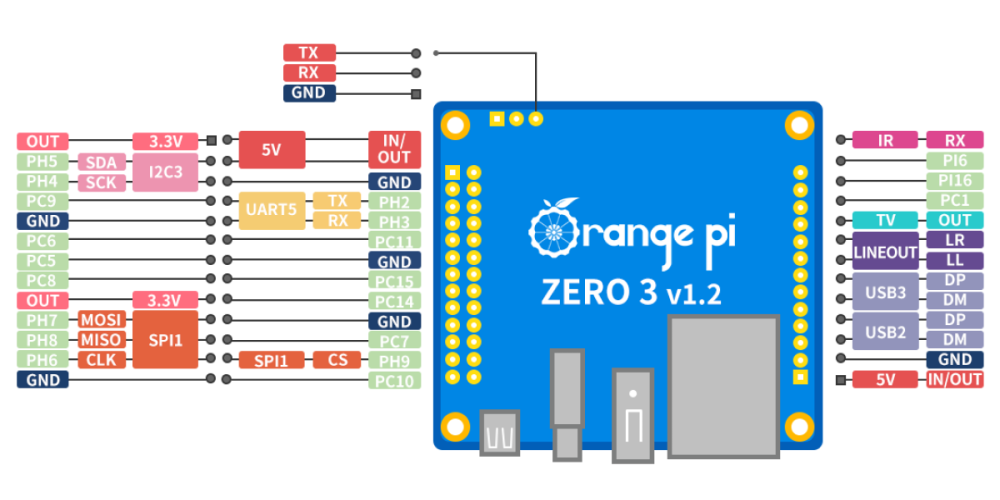
robertoj
Members-
Posts
561 -
Joined
-
Last visited
Content Type
Forums
Store
Crowdfunding
Applications
Events
Raffles
Community Map
Everything posted by robertoj
-

shrink-backup - a tool for backing up sbc:s
robertoj replied to bedna's topic in Software, Applications, Userspace
I tried it... and I wished that the -d option was still there... I had to download an old version... however, it didn't work with -d /dev/mmcblk0 ... it started scanning my nvme root But I like the mechanics and the interface Now I am going to try it the normal way, with latest version. Update: I tried it from my orange pi zero 3, Armbian Linux 6.6 Now I have a 2.7GB IMG file in a USB drive which I bring to my Linux Mint laptop Balena etcher has just finished flashing, and is estimating 30 minutes to validate 2.7 GB completed validating quickly too (I was using the laptop sd writer and that is not as reliable as my very cheap USB microSD writer). The Armbian Image booted just fine in a newer Orange Pi Zero 3. THANK YOU FOR MAKING THIS TOOL. I WILL USE IT MANY TIMES -

OrangePi Zero LTS ili9341 TFT LCD (and later OrangePi Zero 3)
robertoj replied to robertoj's topic in Allwinner sunxi
Thank you for the suggestion With my modified DTS, which takes hints from your DTS and my reference, I get the LCD to display with the DRM driver... but no touch events (with evtest) I dont have more time to analyze this problem for now... but I havent triple checked my connections. Ivano, check whether PI5 (your desired IRQ) is not already claimed by the kernel, with the last command I show up there (pinmux-pins) Maybe you can try other GPIO. Then, if it doesn't work, try changing the level and edge polarity parameter (I talk about it in this thread or the other recent ili9341 thread). In your case: use PI5 <8 5 _>, interrupts = <2 10 2>; /* PC10 - IRQ */ < try changing 2 (active high) into 8 (active low) I HAVE NEVER CHANGED THIS pendown-gpio = <&pio 2 10 1>; /* PC10 */ <try changing 1 (edge rising) into 0 (edge falling) Opiz2w reference: More useful discussion here: https://forum.armbian.com/topic/27457-connecting-banana-pi-m2-zero-with-ili9341-display-over-spi-on-latest-armbian-image/page/2/#comments -
I got the same in my orangepizero3 I looked for it in debian.org https://packages.debian.org/search?keywords=rear&searchon=names&suite=bookworm§ion=all The explanation: it is only available for x86
-
I am glad it worked Are those DTS available somewhere?
-

OrangePi Zero LTS ili9341 TFT LCD (and later OrangePi Zero 3)
robertoj replied to robertoj's topic in Allwinner sunxi
I either have something miswired, or the hardware doesn't like the spi-gpio, but I have constant problems switching into X11. I want to try the most commonly method: one SPI bus, 2 chip selects, as shown in this example: https://github.com/dev-null2019/orangepizero2w35tft/blob/main/joyit35a-overlay.dts But modifying it from opiz2w to opiz3. The DTS by dev-null2019 has this connection wiring list: cs0=ph5 pin 24 (user defined,lcd) cs1=ph9 pin 26 (_____,touch) res=pi6 dc=ph4 irq=ph2 mosi=ph7 (native) miso=ph8 (native) clk=ph6 (native) 3v3=native 0v=native It looks weird to me that in line 9 of the DTS, only the CS0 is specified, but not CS1... is that normal? Is everyone feeeding the LCD with 3.3V or 5V? (I was using 3.3V because that works great in my orange pi zero) Has anyone had success with the backlight gpio parameter? Is it ok to use 5V instead of 3.3v? This would be the modified wiring list, for opiz3: cs0=ph5 pin 24 (user defined,lcd, next to 5V) cs1=ph9 pin 26 (native,touch) res=pc14 dc=pc7 irq=pc10 mosi=ph7 (native, both touch and lcd) miso=ph8 (native, touch only) clk=ph6 (native, both touch and lcd) led=3v3 (native) 5v=pin 5 (native, use next pin ph5 for cs0) 0v=native 11 wires, 2 with Y splitter in physical pin order: 3=cs0 4=5v 17=3v3 18=res < 3v3 for LED 19=mosi 20=gnd < mosi with Y 21=miso 22=dc 23=clk 24=cs1 < clk with Y 26=irq -
Interesting references: https://learn.sparkfun.com/tutorials/how-to-run-a-raspberry-pi-program-on-startup/all https://community.element14.com/products/raspberry-pi/f/forum/5609/launching-an-x11-app-exclusivly-on-startup-with-a-pi https://forums.raspberrypi.com/viewtopic.php?t=314455 https://forums.raspberrypi.com/viewtopic.php?t=353649 https://raspberrypi.stackexchange.com/questions/52099/using-openbox-to-autostart-gui-application-raspberry-pi-3
-
Check the /boot/armbianEnv.txt line "overlays=..." . It should contain "usbhost2 usbhost3" Similar older problem: https://forum.armbian.com/topic/7855-corrupted-armbianenvtxt-in-opz-fails-to-access-expansion-board/ If it doesn't work, check that uboot is not complaining about usbhost2.dtbo, usbhost3.dtbo What other tests did you do?
-
Look for successful or failure experiences in SBCs with the same ARM chip. For example, the banana pi zero m2 zero shares the same chip as the orange pi zero. Execute dmesg|grep w1 to see if the kernel module is loaded Look in the uboot messages, to see if there's an error applying the DTBO Use gpioinfo to see if PA6 is not already claimed by the kernel for something else
-
It would be better if you make a copy of the dtbo from the original folder and name, to the overlays-user folder, then use the user_overlays parameter in armbianEnv.txt to add it. In general, a DTBO copied from one SBC to another, will only work if the Radxa Zero 3W and the Radxa Zero 3 share the same: * CPU chip * chip pinout to the wireless chip * wireless chip * nothing else extra or missing interfering with the chip-wifi channel It is always better to have the DTS (source code of DTBO), so you have full awareness of what it does, and compile with armbian-add-overlay You can try it, then if you don't like the result, disable the dtbo with the user_overlays parameter. ... and report whether it works or not. When the kernel is upgraded, you may get a better support of the chip (if the Radxa or wifi software engineers have done something toward it) When you upgrade kernel, the same DTBO can be used to patch the SBC DTB... unless there's a change in kernel module parameters (rare).
-
Type modinfo rtl88x2bu If it exists in the OS image, you will see a folder path to the kernel module (ko) file If it doesn't exist, find a PC that has the KO and do the same. Take note of the path Learn to build armbian: https://github.com/robertojguerra/orangepi-zero-full-setup/blob/main/README2.md (warning: OUTDATED git command) In the kernel configuration, find the driver option, and change it to M Continue to download and compile Linux and the OS image. Use Balena Etcher and try it again
-

OrangePi Zero LTS ili9341 TFT LCD (and later OrangePi Zero 3)
robertoj replied to robertoj's topic in Allwinner sunxi
OK. I solved the issue of sun50i-h616-pinctrl 300b000.pinctrl: pin PC7 already requested by spi2.0; cannot claim for 300b000.pinctrl:71 by deleting the fragment, which pre-defines the IRQ. See the DTS for touch chip: I see these successful messages The same solution might work for those who want to use native SPI with chip selects, and get the error message I mentioned above -

OrangePi Zero LTS ili9341 TFT LCD (and later OrangePi Zero 3)
robertoj replied to robertoj's topic in Allwinner sunxi
Thank you ag123 Continuing my effort to make ads7846 work with spi-gpio... When I change the GPIO pin from PC7 to PC11 (three places in my DTS), I get the same error: Is my DTS wrong? -

OrangePi Zero LTS ili9341 TFT LCD (and later OrangePi Zero 3)
robertoj replied to robertoj's topic in Allwinner sunxi
I use the Linux official DRM enabled kernel module for ili9341... everybody has this KO... look for it in: roberto@orangepizero3:~/ads7846$ lsmod|grep ili ili9341 12288 0 panel_ilitek_ili9341 16384 0 drm_mipi_dbi 24576 2 ili9341,panel_ilitek_ili9341 roberto@orangepizero3:~/ads7846$ ls /lib/modules/6.6.31-current-sunxi64/kernel/drivers/gpu/drm/tiny/ gm12u320.ko ili9163.ko ili9341.ko mi0283qt.ko repaper.ko st7586.ko hx8357d.ko ili9225.ko ili9486.ko panel-mipi-dbi.ko simpledrm.ko st7735r.ko -

OrangePi Zero LTS ili9341 TFT LCD (and later OrangePi Zero 3)
robertoj replied to robertoj's topic in Allwinner sunxi
This is an example from someone who used a single SPI, with chip selects for LCD and touch (as it is usually done)... for the zero2W (may need slight modification for opiz3) https://github.com/dev-null2019/orangepizero2w35tft/blob/main/joyit35a-overlay.dts -

OrangePi Zero LTS ili9341 TFT LCD (and later OrangePi Zero 3)
robertoj replied to robertoj's topic in Allwinner sunxi
FOR ORANGE PI ZERO 3: This is the version of the LCD DTS, to use NO CS and all pins in the lower end of the connector: ili9341-spi1-opiz3.dts ^ confirmed working in Orange Pi Zero 3, Linux 6.6.31, with drivers included in Armbian 24.8.0-trunk.21 bookworm v My current ATTEMPT to make the touch screen work: ads7846-opiz3-spi-gpio.dts It is not working... the errors may be visible here: More tests: It looks like PC7 is not available for IRQ GPIO due to SPI2... That was unexpected... I will try other pins Does the opiz3 even have a SPI2??? -

OrangePi Zero LTS ili9341 TFT LCD (and later OrangePi Zero 3)
robertoj replied to robertoj's topic in Allwinner sunxi
FOR ORANGE PI ZERO: This is the version of the LCD DTS, to use NO CS and all pins in the lower end of the connector: ili9341-spi1-opiz.dts To make the touch screen work, use this DTS: ads7846-opiz-spi-gpio.dts Confirmed to work in orange pi zero Linux 6.6.44 Wiring schematic later... but they are defined in the code comments -

Orange Pi Zero 3 hotspot/access point not working
robertoj replied to av4625's topic in Allwinner sunxi
I just checked the openwrt webpage. There's no mention of orange pi zero 3 working: https://openwrt.org/toh/xunlong/start The wifi chip is CDtech 20U5622 (or UWE5622) ... do you see that anywhere in openwrt? -
I have 2 of those ili9341+ads7846 LCDs and I already made them work with the banana pi m2 zero and the orange pi zero I needed to use spi-gpio, because I couldn't make both SPI chips work in the same bus. The ili9341 driver is in the Armbian distro, but needs a DTS to let the kernel know that the device is connected to those pins (see my thread about ili9341) The spi-gpio.ko needs to be built by the user. That DTS mentioned above that seems to use 1 bus for 2 SPI devices... so I ask about an actual report whether is works or not. Also: In my experience with bpi m2 zero and opiz, I can't figure out how to make the backlight control work, so the LED signal is connected to 3.3V... so I ask about that DTS: does it work?
-
I recently used Linphone for an audio call from my laptop to my desktop and it works for audio calls in command line mode With video calls, it is promising, but it complains with MSvp8 media errors (most likely can't use decoding libraries) I really want to use them in my armbian SBC since it is so lightweight (and my ili9341 LCD would look nice with a video call ) Does anyone here have experience with Linphone and BareSIP (another SIP video client, even more lightweight). The only discussion I see about it is in the Linphone google group and the german forum for "DoorPi"... but I can't see a guide to install and use it.
-
https://forum.armbian.com/topic/29202-orange-pi-zero-3/?do=findComment&comment=193374 Does this ILI9341+touch DTS work for the Orange Pi Zero 3? (with or without backlight control)
-

Radxa Zero 3W Resistive TouchScreen XPT2046
robertoj replied to maximilian fletkar's topic in Radxa Zero 3W/3E
Document everything in your DTS, including how you calculate the GPIO numbers and the describe the physical wiring Make sure you use armbian-add-overlay correctly, and armbianEnv.txt doesn't include previous dtbo experiments. Send a schematic of your touch chip pins and your ARM board This is a reference on how it is done with an Allwinner H3 and spi-gpio. https://forum.armbian.com/topic/27457-connecting-banana-pi-m2-zero-with-ili9341-display-over-spi-on-latest-armbian-image/?do=findComment&comment=202734 Try changing the active-high/active low/edge up/edge down parameters -

OrangePi Zero LTS ili9341 TFT LCD (and later OrangePi Zero 3)
robertoj replied to robertoj's topic in Allwinner sunxi
When the chip select is not specified, as above, the gpio pin is available for other uses I read somewhere that the ili9341 does not need the MISO wire because no information is read from the LCD ever... is this true? Some people are getting away with it https://forums.raspberrypi.com/viewtopic.php?t=370089 Also, if a wire is loose momentarily, the LCD locks up or turns "white-washed"... is there a way to reset the LCD and its KO module? -
Are you a linux beginner also? Have you operated linux computers through SSH? What is your objective with an SBC? Desktop, server, media player, robot controller? This is the best guide around: https://github.com/robertojguerra/orangepi-zero-full-setup Keep in mind that following guides made years ago may not be valid anymore, and you need to research how to make it work Community suppport means: you ask questions in the forum, and someone who had the experience answers it


